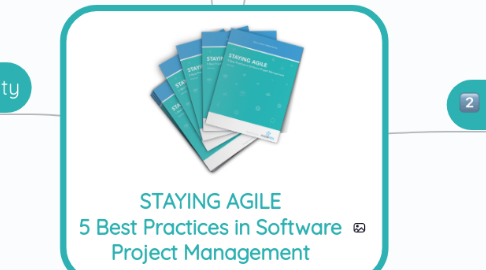
1. Resources
1.1. Download the Free White Paper
1.2. Manifesto for Agile Software Development
1.3. Collaborative Task Management for Teams
2. Sustainable Productivity
2.1. Achieve team efficiency long-term
2.2. Review Productivity via Sprint Retrospectives
2.2.1. Client satisfaction
2.2.2. Cycle time of particular backlog items
2.2.3. QA kickback rate
2.3. Use Kanban boards to assess where bottlenecks are being created
2.4. Create sustainable workflows
2.4.1. Ensure that your team is not overloaded with features within each Sprint
2.4.2. Be consistently open and honest with clients to ensure that not too many features are added
3. Collaborating Cross-departmentally
3.1. Enable constant communication between your business and development teams
3.1.1. "Any Agile approach used by the development team must support all business needs and address all stakeholder concerns" - Dorian Simpson
3.2. Prevent Siphoning with Online Communication
3.2.1. Find a solution that is easy enough to use for everyone
3.2.2. Create a bridge between different departments, enabling everyone to remain on the same page with project progression.
4. Establishing the ‘Why’:
4.1. Begin every project with a strategy sprint
4.2. Focused on identifying
4.2.1. Which pain points will be solved
4.2.2. Which unique experience or service the proposed product would support
4.3. Define vision and communicate it to the team!
4.4. 5-Day Strategy Sprint Agenda
4.4.1. Day 1: Map out the pain point or need for the product
4.4.2. Day 2: Establish existing competing solutions
4.4.3. Day 3: Use the initial ideas to establish a testable hypothesis
4.4.4. Day 4: Create a rough product prototype
4.4.5. Day 5: Test the prototype on prospective end-users (i.e. real human beings)
5. Planning to Perfection
5.1. Provide a Realistic Project Scope & Budget
5.2. Establish an Agreed Project Scope
5.2.1. Create a project mind map for each new client during the project consultation stage
5.2.2. Align expectations
5.2.3. Ensure all key features have been considered in the price
5.3. Use pricing process based on the cone of uncertainty
5.3.1. Help client make informed decisions
5.3.1.1. proactive project updates
5.3.1.2. weekly client meetings
6. Customer Values
6.1. Engage with client and user feedback at every iteration
6.2. Key steps for achieving rapid and regular end-user insight
6.2.1. Access
6.2.2. Listen
6.2.3. Communicate
